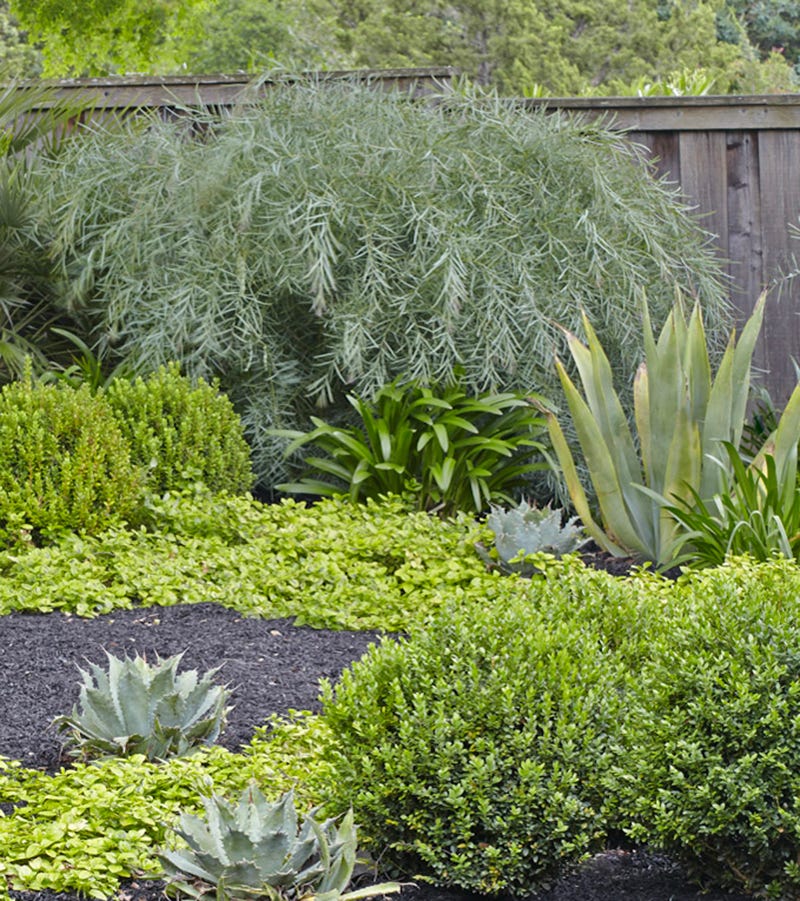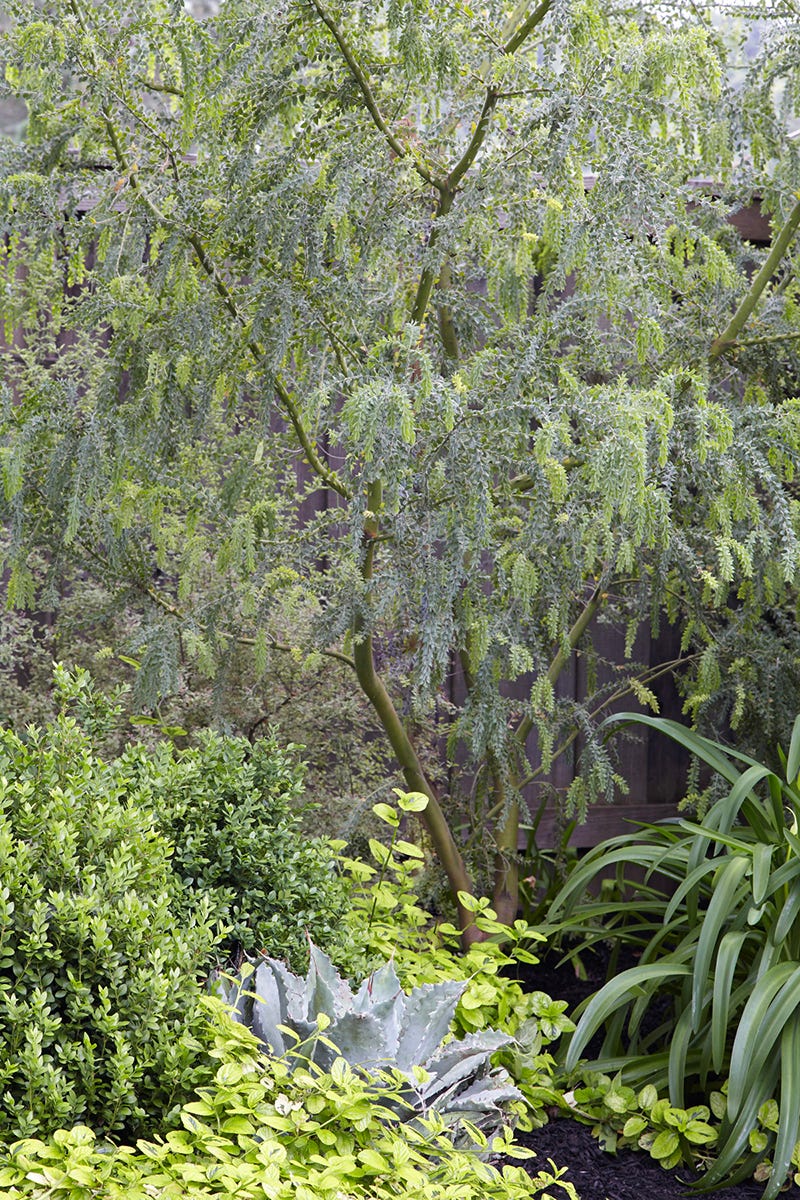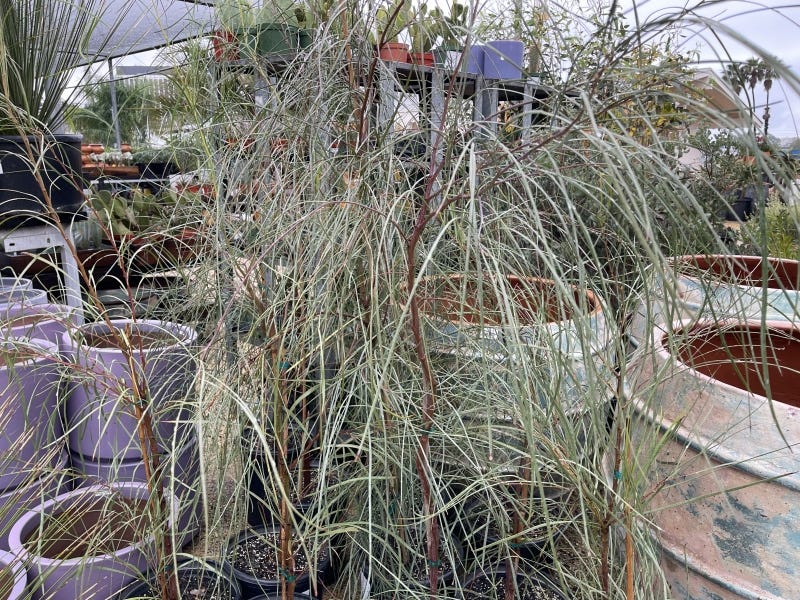Acacias - who's afraid of little old me?
Let's put the common notion that Acacias are simply weeds that produce allergies to bed already.
Homestead Design Collective’s lead designer, Christian Cobbs shares a few of our favorite acacias for the garden.
Yes, there are a few bad actors such as Acacia dealbata and Acacia melanoxylon that definitely are weeds here in the SF Bay Area, but there are over 1,000 species of Acacia and many of them make splendid garden subjects. They are rejected by deer, most are evergreen, they tolerate drought, and they are generally very fast growing. As for the allergy thing, studies out of Australia (the epicenter of Acacia diversity) have shown that Acacia pollen is very heavy and isn't typically carried very far in the air, so it's unlikely that this is what is causing your sneezing unless you are sticking your nose directly into the tree (not advised). As vast as the genus may be, we will only focus on some of the Acacia which make excellent small trees and/or screening material in this article. It is safe to assume that all of these species will prefer full sun to do their best.

Acacia iteaphylla
This plant has been gaining popularity in recent years in California, and with good reason....it's incredibly useful and durable. Growing up to 8-10' tall and just as wide with intricately intertwined branches, Acacia iteaphylla is a very useful screening plant that is both dense enough to not be able to see through, but also light enough to not feel heavy. Commonly known as the ‘Willow Wattle’, the branch tips droop gracefully, delicately clothed with narrow, ever-gray, willow-like foliage. This tree has proven to be very adaptable to our region, tolerating a wide range of soils, heat, drought, and coastal situations. It is also quite cold hardy to boot, living comfortably down to 15-20 degrees, which makes it a splendid subject for most Bay Area gardens. Plant iteaphylla as a one-off where you need something ugly to go away, or plant it as an informal hedge or as a backdrop to a meadow of grasses.....the textures harmonize beautifully together. The willowy texture also contrasts wonderfully with big bold agaves and Aloes in a dry garden setting.

Acacia cultriformis
Commonly known as the ‘Knife Leaf Wattle’, Acacia cultriformis is one of the best small trees that you can include in a dry landscape. It is wonderfully sculptural with gaunt and ascending branches closely stacked with alternating blue-green "teeth". The Acacia cultriformis is both dense enough to provide adequate screening in a garden and also open enough to allow for sun-loving succulents and other arid treasures to grow beneath them. Fast growing to 10-15' high and wide, this tree is easy to tuck into almost any sunny spot in the garden and as with most Acacias, bloom time is in the winter providing off season color. When the weather cools the festooned branches will droop with the weight of the bright yellow blossoms. The cultriformis looks great as a specimen focal point in a garden mixed with agaves, senecio mandraliscae, euphorbia characias wulfenii, and other plants with similar glaucous tones in their foliage.
If left untended, Acacia cultriformis can grow into a multi-trunked shrub (which is beautiful), but if you prefer a more traditional tree shape, it can easily be limbed up and thinned out to create a more classic arboreal form. The cultriformis is also great utilized in a grove or in a hedgerow where quick screening is needed. Hardy to below 20 degrees.

Acacia vestita
The ‘Hairy Wattle’ is my favorite of the bunch. It has similar foliage in appearance to Acacia cultriformis, but the leaves are thinner and covered in small hairs. The form of this small tree is just gorgeous. Branches delicately weep to form a relatively dense canopy 12-15' high and wide, and, like cultriformis, this plant is easily limbed up to allow for more light to reach the ground underneath. In addition to stunning good looks, acacia vestita is also quite adaptable (we have so much in common!) - tolerating both short periods of saturation as well as drought. As a tree it makes a nice focal point in a border, and also can fill in a corner nicely, creating a lovely backdrop. This plant looks especially smart combined with anigozanthos, droopy, colorful phormiums, and also calandrinia spectabilis among others. Listed as hardy to only 20-25 degrees, the acacia vestita is a tad more tender than the two species. That being said, we have had no problems with frost in more inland locations like Sonoma or Healdsburg, so we will tentatively consider this one hardy in most Bay Area gardens.

Acacia stenophylla
The Shoe-String Acacia is one of the coolest trees you can plant in a small garden. For those familiar with San Francisco, you may recognize this as the tree planted in the median on Guerrero Street in the Mission where it performs well with little input. Growing to about 20-30' high and about half as wide, this tree is ideal for small, narrow gardens where one needs height for screening but doesn't have the space to accommodate a spreading canopy. The foliage is super sexy and lives up to its common name with very long (to 12"), very thin, slightly twisted leaves dangling downward from the branches, creating a lovely tracery. Dense enough to screen out unwanted slights, the acacia stenophylla is also thin enough to cast only light shade, making it an ideal vertical accent to any sort of dry garden. It looks nice contrasting with bolder foliage accents in the garden like agave and aloe, and also as a complement to wispier plants such as Mexican weeping bamboo, cape rush and grevillea. This acacia wants decent drainage and as much sun as possible for it to thrive, but is also versatile enough to tolerate moderate salt and wind, making the stenophylla a good candidate for coastal gardens, and high heat allowing to function well farther inland. Hardy to the low 20s, this tree fairs well in most Bay Area gardens.

Acacia baileyana 'Purpurea'
Known as the ‘Cootamundra Wattle’, Acacia baileyana straight species is typically not considered a first class gardening subject. However, the 'Purpurea' is a different story altogether. Native to a small region of New South Wales in Australia, this tree has proven to be extremely adaptable in gardens throughout temperate Mediterranean climates all over the world. This is a good tree to plant out in the back 40. It can veer a little too scruffy planted in highly interactive areas of the garden, but makes a superior subject for planting on the periphery of the garden, or a transition from a manicured to less manicured section of the garden. From a foliage standpoint, it is one of the most standout species in the genus. Feathery new growth emerges dark burgundy, flushing to dusty purple as it transitions to a beautiful blue grey. This tree grows to about 20' tall, but is a bit more of a spreader than the other Acacias we have covered, with ultimate canopy spread 20-30' across. The ‘purpurea’ is stunning planted in a meadow situation where its beautiful colors contrast nicely with the lime-green tones of Lomandra 'Breeze' or, likewise, complementing the grassy colors of gold and green like Leymus condensatus 'Canyon Prince' and Helictotrichon sempervirens. This plant is hardy to heat and cold and is tolerant of many adverse soil conditions, making the acacia baileyana ‘purpurea’ an ideal candidate throughout Bay Area gardens.




The world of acacias has been overwhelming so this is the breakdown I needed! Thank you for sharing, loving your substack as I navigate replacing everything in our yard with drought tolerant plants.